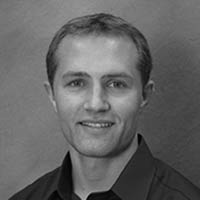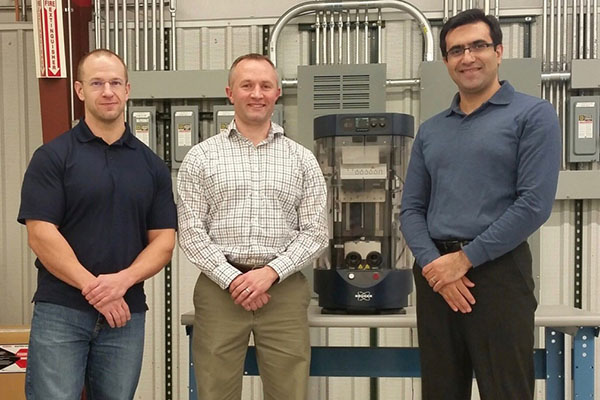
BUFFALO, NY – January 21, 2016 – Sentient Science, the leader in software solutions to extend the life of mechanical systems, announced today that Dr. Nick Weinzapfel, Ph.D., has joined its team of brilliant scientists as Chief Scientist for Computational Bearings. Dr. Weinzapfel will be responsible for the development and application of bearing prognostics tools within DigitalCloneLive for Operators and DigitalCloneLive for Suppliers. Dr. Weinzapfel will reunite with his colleagues from Purdue University, Dr. Nathan Bolander and Dr. Behrooz Jalalahmadi, all three of whom received their Doctorates of Philosophy from Purdue University.
Bearings are the “microprocessor” of rotating machines. Without the right microprocessor, computers, applications and even the internet cannot operate. The same goes for rotating equipment. It is essential for operators and suppliers to understand bearing behavior today using our three levels of future failure visibility:
- Visibility 1: Now (0 to 12 months) Forecasts what components will fail in the next 90 days, also known as “imminent death.” Vice presidents of operations, monitoring and engineering are typically concerned about this.
- Visibility 2: Mid-term (18 months to 3 years) What will fail in the midterm and how do I extend life? Vice presidents of assets tend to look at this data. People who budget for the year, forecast every 30 days and plan every 60 days.
- Visibility 3: Long term (3 to 20 years) What is an asset’s true life prediction and how can I reduce the risks? Chief executive officers, chief financial officers and vice presidents of risk want to know this information.
This makes choosing the right bearing crucial to all levels of management, because understanding this critical rolling component in a system is the only way to deliver life extension and operating and maintenance (O&M) cost reduction knowledge. Understanding the behavior of a bearing is a complex and difficult process. It took Sentient 10 years to perfect its DigitalClone models, and Dr. Weinzapfel, Dr. Bolander and the R&D team will now see it into the future.
Sentient Science, a trusted third party, offers low cost computational testing to operators and suppliers using a materials science-based prognostics simulator that continually runs millions of tests on rotating assets using 8,000 microprocessors, 24-hours a day, seven-days a week, 365-days per year.
“We are ecstatic that Nick has decided to join our team. We’ve admired his work for quite some time, and we are thrilled that we’ll be able to use his expertise in the dynamics and materials science of energy and transportation bearings. We are now engaging bearing suppliers worldwide and making our solutions available to operators across the DigitalClone operator network,” said Dr. Nathan Bolander, Chief Technology Officer at Sentient Science. “Bearings are typically the root cause of wind turbine and aerospace failures, and Nick will lead our bearing team so that we can provide the next generation DigitalClone Models with the three levels of visibility within DigtialCloneLive. Nick will introduce Sentient’s new ‘imminent death’ product soon.”
Dr. Weinzapfel holds his Ph.D. in Mechanical Engineering from Purdue University and spent the last 3.5 years leading R&D of life extension and asset management technologies at Schaeffler Group, a major bearing supplier for the wind energy industry, before coming to Sentient Science to lead the R&D efforts of bearings applications for DigitalClone Solutions.
“Many of our materials scientists achieved their Ph.Ds. at Purdue University and the University at Buffalo,” Bolander noted. “Our plans to keep expanding into new markets while building more partnerships with universities align perfectly with the on boarding of Dr. Weinzapfel. He will make an excellent addition to our talented team of innovators, and I can’t wait to see the amazing things that will come from his work.”
“It’s like coming home,” said Dr. Weinzapfel. “I have worked with many members of the Sentient team over the last eight years at Purdue University and also as Chairman of the Bearing Committee at STLE (Society of Tribology and Lubrication Engineers). Relationships are very important to my success and I invite my long-standing colleagues at Schaeffler, Timken and SKF to participate in my bearing research here at Sentient Science.”
Sentient Science has doubled its workforce since 2014 and is on trajectory to double again by 2017. Sentient hires world class mechanical engineers, most with Ph.Ds., to help wind turbine operators lower their Levelized Cost of Energy Calculator (LCOE), through their patent-pending materials science-based DigitalClone® life prediction, life extension and Buy On Life products. In just 18 months, Sentient has more than 14,700 gearboxes under contract. Dr. Weinzapfel’s research will accelerate that momentum. Sentient’s R&D team now totals 13.
# # #
